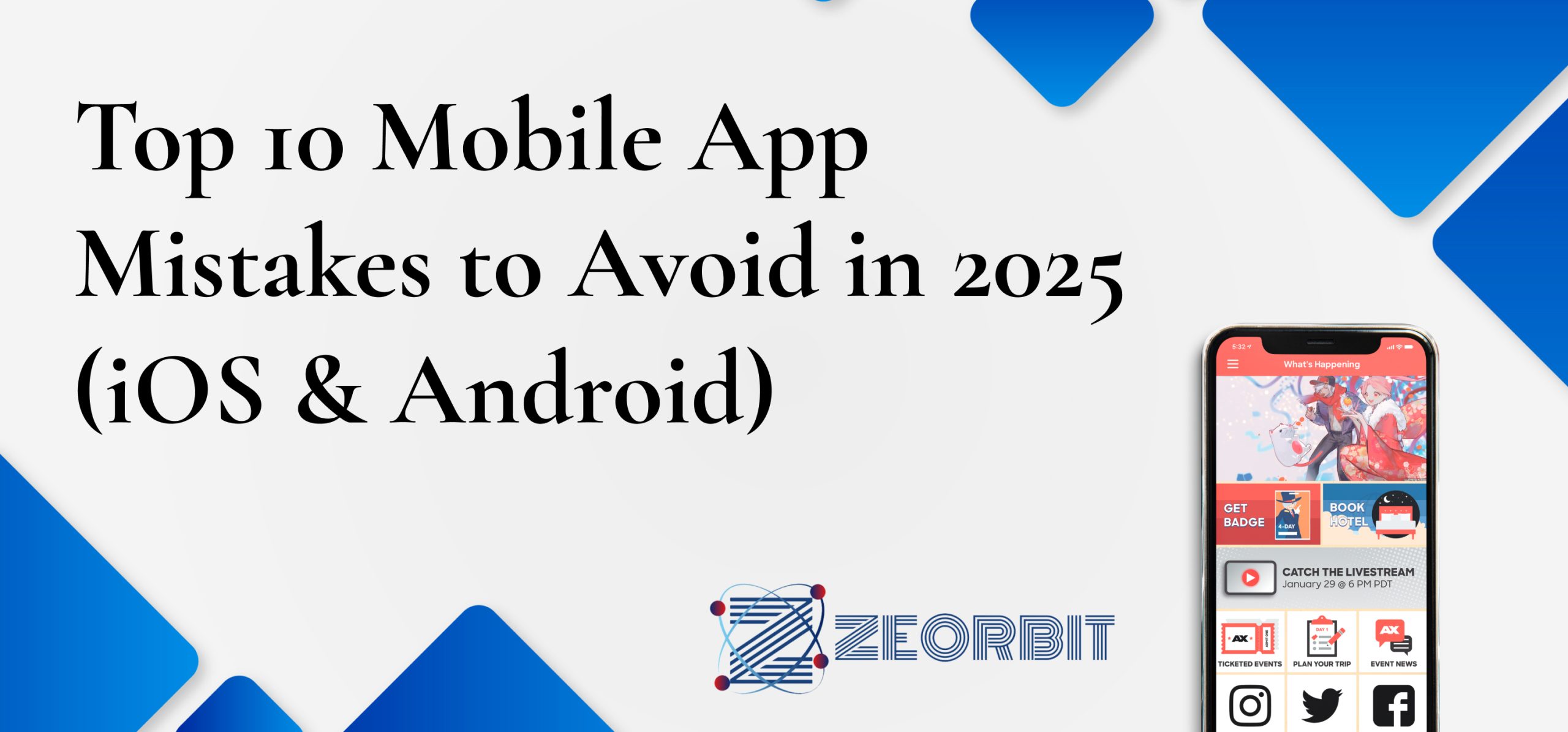Top 10 Mobile App Mistakes to Avoid in 2025 (iOS & Android)
Top 10 Mobile App Mistakes to Avoid in 2025 (iOS & Android)
The mobile app market is a hyper-competitive arena, where innovation and user experience reign supreme. A single misstep can spell disaster, relegating your carefully crafted app to the digital graveyard. Here’s how to avoid the most common pitfalls that plague mobile app development today.
1. Neglecting User Research and Market Analysis
Launching an app without knowing your target audience is like navigating without a map. Understanding user needs, preferences, and pain points is paramount to building an app that resonates.
Before you even write a single line of code, invest in thorough user research and market analysis.
- Who are your ideal users? Create detailed user personas.
- What problems are you solving? Clearly define your value proposition.
- Who are your competitors? Analyze their strengths and weaknesses.
- What are the emerging trends in your niche? Stay ahead of the curve.
Ignoring these crucial steps leads to apps that nobody wants or needs, a costly and avoidable mistake.
2. Poorly Defined User Experience (UX) and User Interface (UI) Design
In today’s app landscape, a clunky, confusing interface is a death sentence. Users expect seamless, intuitive experiences that are visually appealing.
- Prioritize usability: Ensure your app is easy to navigate and understand.
- Focus on aesthetics: Invest in a modern, visually appealing design.
- Optimize for mobile: Design with smaller screens and touch interactions in mind.
- Follow platform guidelines: Adhere to iOS and Android design standards.
Mistake: Cramming too much information onto a single screen.
Solution: Employ minimalist design principles, using white space and clear typography.
How to test: Conduct user testing early and often to gather feedback and iterate on your design.
3. Ignoring Performance Optimization
Slow loading times, crashes, and excessive battery drain are major turn-offs. Users have zero tolerance for poorly performing apps.
- Optimize code: Write efficient code to minimize resource consumption.
- Compress images: Reduce image sizes without sacrificing quality.
- Implement caching: Store frequently accessed data locally for faster retrieval.
- Test on various devices: Ensure your app performs well on different screen sizes and hardware configurations.
Pro Tip: Use profiling tools to identify performance bottlenecks and address them proactively.
4. Overlooking Security Vulnerabilities
Security breaches can damage your reputation and erode user trust. Protecting user data should be a top priority.
- Implement secure authentication: Use strong passwords and multi-factor authentication.
- Encrypt sensitive data: Protect data both in transit and at rest.
- Regularly update dependencies: Keep your app’s libraries and frameworks up to date to patch security vulnerabilities.
- Conduct penetration testing: Hire security experts to identify and exploit potential weaknesses.
Warning: Failure to address security vulnerabilities can result in serious legal and financial consequences.
5. Failing to Plan for Scalability
Your app’s success hinges on its ability to handle increased traffic and data volume. Designing for scalability from the outset is crucial.
- Use a scalable architecture: Choose a robust and flexible infrastructure.
- Implement load balancing: Distribute traffic across multiple servers to prevent overload.
- Optimize database performance: Ensure your database can handle a growing volume of data.
- Monitor performance metrics: Track key performance indicators to identify potential bottlenecks.
The key is: Don’t wait until your app is struggling to handle the load. Plan ahead for growth.
6. Neglecting Cross-Platform Compatibility
Limiting your app to a single platform restricts your potential audience. Consider building for both iOS and Android to maximize reach.
- Use cross-platform frameworks: Tools like React Native, Flutter, and Xamarin allow you to develop apps that run on both platforms from a single codebase.
- Adapt UI elements: Adjust the UI to match the specific design conventions of each platform.
- Test thoroughly on both platforms: Ensure your app functions correctly on both iOS and Android devices.
Benefits: Increased reach, reduced development costs, and faster time-to-market.
7. Ignoring App Store Optimization (ASO)
Even the best app will languish if it’s not discoverable. ASO is the process of optimizing your app’s listing in the app stores to improve its visibility.
- Choose relevant keywords: Research and target keywords that users are likely to search for.
- Craft a compelling app description: Highlight your app’s key features and benefits.
- Use high-quality screenshots and videos: Showcase your app’s design and functionality.
- Encourage reviews and ratings: Positive reviews and ratings can significantly boost your app’s ranking.
Remember: ASO is an ongoing process. Continuously monitor your app’s performance and adjust your strategy accordingly.
8. Not Implementing Analytics and Tracking
You can’t improve what you can’t measure. Implementing analytics and tracking is essential for understanding how users are interacting with your app.
- Track key metrics: Monitor user engagement, retention, and conversion rates.
- Identify areas for improvement: Use analytics data to identify pain points and optimize the user experience.
- A/B test different features: Experiment with different approaches to see what works best.
- Use analytics to inform your marketing strategy: Track the effectiveness of your marketing campaigns and adjust your strategy accordingly.
Key tools: Google Analytics, Firebase Analytics, and Amplitude.
9. Poor Post-Launch Support and Updates
An app isn’t a one-and-done product. Providing ongoing support and updates is crucial for maintaining user satisfaction and engagement.
- Respond to user feedback: Address bug reports and feature requests promptly.
- Release regular updates: Fix bugs, add new features, and improve performance.
- Keep up with platform updates: Ensure your app is compatible with the latest versions of iOS and Android.
- Provide excellent customer support: Offer multiple channels for users to get help, such as email, phone, and in-app support.
Fact: Users are more likely to stick with an app that receives regular updates and responsive support.
10. Lack of a Monetization Strategy
Having a clear monetization strategy is vital for long-term success. Without a sustainable revenue model, your app will struggle to survive.
- Freemium: Offer a basic version of your app for free and charge for premium features.
- In-app purchases: Sell virtual goods, subscriptions, or other digital content within your app.
- Advertising: Display ads within your app (be mindful of user experience).
- Subscriptions: Charge users a recurring fee for access to your app’s features.
Important note: Choose a monetization strategy that aligns with your app’s value proposition and target audience. Avoid overly aggressive monetization tactics that can alienate users.
FAQ:
- How much does it cost to develop a mobile app?
The cost varies greatly depending on the complexity of the app, the platform(s) it’s being developed for, and the development team’s location. A simple app can cost as little as $10,000, while a complex app can cost upwards of $100,000. - How long does it take to develop a mobile app?
The timeline also depends on the complexity of the app. A simple app can be developed in a few weeks, while a complex app can take several months. - What is the best programming language for mobile app development?
The best language depends on the platform. Swift is the primary language for iOS development, while Kotlin and Java are the primary languages for Android development. Cross-platform frameworks often use Javascript, Dart, or C#. - How do I market my mobile app?
ASO is essential, but also consider social media marketing, paid advertising, public relations, and influencer marketing.
By avoiding these common mistakes and focusing on user experience, performance, security, and scalability, you can significantly increase your chances of success in the competitive mobile app market. The landscape is ever-changing, so constant learning and adaptation are crucial.


